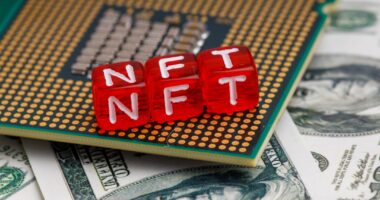Ethereum, a decentralized blockchain platform, has revolutionized the way digital assets are created, managed, and exchanged. Launched in 2015 by Vitalik Buterin and a team of developers, Ethereum introduced the concept of smart contracts—self-executing contracts with the terms of the agreement directly written into code. This innovation allowed developers to build decentralized applications (dApps) on its blockchain, paving the way for a myriad of use cases, including the burgeoning field of non-fungible tokens (NFTs).
NFTs are unique digital assets that represent ownership of a specific item or piece of content, such as art, music, or virtual real estate. Unlike cryptocurrencies like Bitcoin, which are fungible and can be exchanged on a one-to-one basis, NFTs are distinct and cannot be replaced with something else. The rise of NFTs has captured the imagination of artists, collectors, and investors alike, leading to a cultural phenomenon that transcends traditional boundaries.
The Ethereum blockchain serves as the backbone for most NFT transactions, providing a secure and transparent environment for creators and buyers. The ERC-721 and ERC-1155 token standards have become the foundation for NFT creation on Ethereum, enabling developers to mint unique tokens that can represent ownership of digital assets. As the NFT market continues to expand, Ethereum’s role as the primary platform for these tokens solidifies its position in the digital economy.
Key Takeaways
- Ethereum is a blockchain platform that enables the creation and trading of NFTs, which are unique digital assets.
- Ethereum has revolutionized the NFT market by providing a secure and decentralized platform for buying, selling, and trading digital collectibles.
- Emerging trends in NFTs include the use of NFTs in gaming, virtual real estate, and digital art, all of which are powered by Ethereum’s blockchain technology.
- Ethereum plays a crucial role in authenticating and verifying the ownership of NFTs, providing a transparent and immutable record of ownership.
- Ethereum’s influence on NFT marketplaces has led to the development of user-friendly platforms for buying, selling, and exchanging NFTs, making them more accessible to a wider audience.
Ethereum’s Impact on the NFT Market
Ethereum’s influence on the NFT market is profound and multifaceted. As the first blockchain to support NFTs, it has established itself as the go-to platform for creators and collectors. The ability to create unique tokens on Ethereum has led to an explosion of digital art and collectibles, with platforms like OpenSea, Rarible, and Foundation emerging as popular marketplaces for buying and selling NFTs.
These platforms leverage Ethereum’s smart contract capabilities to facilitate secure transactions, ensuring that ownership is verifiable and immutable. Moreover, Ethereum’s robust ecosystem has attracted a diverse range of artists and creators who are eager to explore new revenue streams through NFTs. Musicians can release exclusive tracks as tokens, while game developers can create in-game assets that players can truly own.
This democratization of ownership has empowered creators to connect directly with their audiences, bypassing traditional gatekeepers in the art and entertainment industries. The result is a vibrant marketplace where creativity flourishes, driven by Ethereum’s technological capabilities.
Emerging Trends in NFTs

As the NFT landscape evolves, several emerging trends are shaping its future. One notable trend is the increasing intersection of NFTs with gaming. Blockchain-based games like Axie Infinity and Decentraland have demonstrated how NFTs can be integrated into gameplay, allowing players to own in-game assets that hold real-world value.
This shift not only enhances player engagement but also creates new economic models within gaming ecosystems. Players can trade or sell their assets on secondary markets, further blurring the lines between gaming and investment. Another significant trend is the rise of utility-driven NFTs.
Beyond mere collectibles, these tokens are being designed to offer tangible benefits to their holders. For instance, some NFTs grant access to exclusive events, content, or experiences, creating a sense of community among holders. This trend reflects a broader understanding that NFTs can serve practical purposes beyond ownership, fostering loyalty and engagement among fans and collectors.
As creators continue to innovate, we can expect to see even more diverse applications for NFTs across various industries.
The Role of Ethereum in NFT Authentication and Ownership
One of the most critical aspects of NFTs is their ability to provide verifiable proof of ownership and authenticity. Ethereum plays a pivotal role in this process through its decentralized ledger technology. When an NFT is minted on the Ethereum blockchain, it is assigned a unique identifier that distinguishes it from all other tokens.
This identifier is recorded on the blockchain along with metadata that describes the asset it represents—be it an artwork, music file, or virtual item. The transparency of Ethereum’s blockchain ensures that anyone can verify the ownership history of an NFT. This feature is particularly important in combating issues like forgery and plagiarism in the digital art world.
Artists can confidently sell their work as NFTs, knowing that buyers can trace its provenance back to them. Additionally, smart contracts facilitate automated royalty payments to creators whenever their NFTs are resold, ensuring that artists continue to benefit from their work long after the initial sale. This combination of authentication and ongoing revenue streams has made Ethereum an indispensable tool for artists navigating the complexities of digital ownership.
Ethereum’s Influence on NFT Marketplaces
The emergence of NFT marketplaces has been significantly influenced by Ethereum’s capabilities. Platforms like OpenSea and Rarible have harnessed Ethereum’s smart contract functionality to create user-friendly environments where buyers and sellers can interact seamlessly. These marketplaces allow users to browse vast collections of NFTs, place bids in auctions, and execute transactions with confidence, all while relying on Ethereum’s secure infrastructure.
Furthermore, Ethereum’s popularity has led to increased competition among marketplaces, driving innovation in features and services offered to users. For instance, some platforms are experimenting with social features that allow users to follow their favorite creators or showcase their collections in customizable galleries. Others are exploring ways to integrate DeFi (decentralized finance) elements into NFT trading, enabling users to leverage their digital assets for loans or yield farming opportunities.
As these marketplaces continue to evolve, they will play a crucial role in shaping the future dynamics of the NFT ecosystem.
NFT Fractionalization and Ethereum’s Role

Here is the rewritten text with 3-4 **Democratizing Access to High-Value Digital Assets**
NFT fractionalization is an innovative concept that allows multiple investors to own a share of a single NFT by dividing it into smaller fractions or tokens. This approach democratizes access to high-value digital assets that may otherwise be out of reach for individual buyers.
**How Fractionalization Works**
For example, consider a high-profile digital artwork sold as an NFT for millions of dollars. Through fractionalization, this asset can be divided into hundreds or thousands of smaller tokens, each representing a fraction of ownership. Investors can buy these fractions at a lower price point, allowing them to participate in the potential appreciation of the asset without needing substantial capital upfront.
**The Rise of Fractional Ownership Platforms**
Platforms like Fractional.art have emerged specifically to facilitate this process on Ethereum, showcasing how fractional ownership can open new avenues for investment in the NFT space. By leveraging Ethereum’s smart contracts, fractionalization enables seamless transactions and governance among fractional owners.
Future Integrations of Ethereum and NFTs
Looking ahead, the integration of Ethereum with other technologies promises exciting possibilities for the future of NFTs. One area ripe for exploration is interoperability between different blockchains. As various blockchain networks develop their own NFT standards, there is growing interest in creating bridges that allow assets to move seamlessly between ecosystems.
Such interoperability could enhance liquidity in the NFT market and provide users with more options for trading and utilizing their digital assets. Additionally, advancements in Layer 2 solutions—scaling solutions built on top of Ethereum—are likely to play a significant role in shaping the future of NFTs. These solutions aim to reduce transaction fees and increase throughput on the Ethereum network while maintaining security and decentralization.
By enabling faster and cheaper transactions, Layer 2 solutions could facilitate more frequent trading of NFTs and encourage broader participation from users who may have been deterred by high gas fees on the main Ethereum network.
The Future of Ethereum and NFTs
The future of Ethereum and NFTs is poised for continued growth and innovation as both technologies evolve in tandem with one another. As more creators embrace NFTs as a means of expression and monetization, Ethereum will remain at the forefront of this movement due to its established infrastructure and community support. The ongoing development of new standards, marketplaces, and applications will further enhance the utility and appeal of NFTs across various sectors.
Moreover, as regulatory frameworks around digital assets become clearer, institutional interest in NFTs may increase significantly. This could lead to greater legitimacy for the market as well as new opportunities for collaboration between traditional industries and blockchain technology. With its unique combination of decentralization, security, and programmability, Ethereum is well-positioned to navigate these changes while continuing to empower creators and collectors alike in the ever-evolving landscape of digital ownership.





